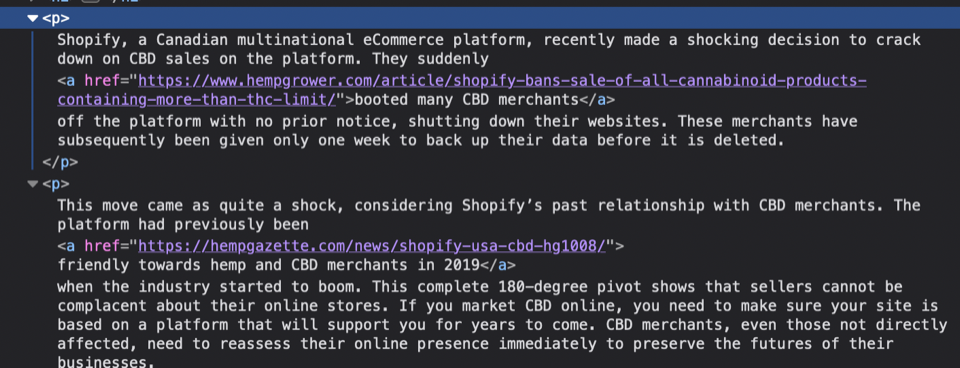Backlinks are threads that build and bind the internet together. They are inbound links that link from one website back to another. You can think of them as citations or references like those you might find in a book or on Wikipedia. A dead backlink refers to links that do not work due to outdated URLs or pages that have been combed or gone inactive. Common examples include pages that are built to exploit search engine algorithms with clever linking but were then caught and blacklisted. If you had backlinks with one of these websites, they’d be broken.
Link rot, or the growing prevalence of broken backlinks, is becoming an increasingly noticeable problem both for informational web pages and ecommerce players that rely on building backlinks for SEO value. New research shows that, as recently as 2018, 6% of links from articles were inactive and therefore of no use.
Benefits of Fixing Broken Links
When a link goes down like this, you stop gaining any value from it. It is at that point considered inactive or dead and must be fixed either through reclaiming or link building. The reason it’s so important for business owners to stay on top of backlinks is that a large number of dead backlinks can cause your search engine rankings to tank. You might have an outstanding content strategy, but if your site can’t get to the top of SERPs and get quality traffic, it’ll be of no use. Other benefits of building broken backlinks include:
- Get recognition from pages with high domain authority, which boosts your own pages’ search engine rankings and gets other pages’ audiences interested in your site.
- Give you an edge over your competitors by allowing you to create relevant content that drives visitors to your site instead of theirs.
- Complement your SEO strategy.
- Improve the overall user experience of browsing your website. If users find broken links, they can find the experience frustrating and be less likely to return in the future.
Reclaiming vs Building
Although both terms get used interchangeably quite often, there is a subtle difference between the two. Link reclaiming refers to the process of literally reclaiming lost SEO value, a process involving finding broken backlinks and manually fixing them by updating the URLs and removing links that can’t be updated.
Building lost backlinks, on the other hand, is a clever way of responding to dead links that targets competitors’ broken links and captures their SEO value by recreating content and using high DA websites to link to your content instead of theirs. These approaches to dead links offer flexibility when it comes to tackling this issue, and, if done well, both can increase traffic in the future.
Reclaiming Broken Backlinks
Analysis
Reclaiming dead links begins with analysis. The first step here is running a deep crawler that will comb through websites and search for orphan pages and other relevant results. Backlink building tools like Ahrefs and Google Search Console are easy-to-use deep crawlers that you can use without worry. They are both hosted on a robust backend.
Sometimes the dead link is just a result of a minor typo; this occurs more than people realize. Research shows that 45% of users land on 404 pages because of typos. If your backlink problem is because of a typo, you might not have to go through the trouble of doing a deep crawl. As a best practice, however, it’s always a good idea to be thorough and execute one so you don’t miss anything.
Ahrefs
Ahrefs differentiates itself from the competition with detailed backlink-building tools that offer you more insight than you might get from competing websites. The most relevant example is the automatic report feature that compiles and presents relevant information on broken backlinks at a glance. This report shows you which backlinks you can reclaim and lets you filter the available links into different categories, depending on what you’re looking for.
Google Search Console
For those still learning and experimenting with building backlinks, Google Search Console (GSC) is a great free alternative to other services like SEO Spider that are only partially free. GSC might lack the data visualization and reporting capabilities of robust services like Ahrefs, but you’ll be able to identify dead links using GSC all the same. To get started, use the Crawl feature to get a listing of links and see what catches your eye. You’ll be able to view important data about each dead link such as the date it stopped working.
The downside of GSC arises from one of the things that makes Google the go-to search engine — index accuracy. Given the speed at which Google indexes links all the time, GSC data isn’t always 100% on the mark, and some cross-checking might be needed to verify data.
Categorization
The next step in building a better backlink network is organizing the results you’ve gotten after your crawl. If you’re using a service like Ahrefs, you won’t have to worry about doing this manually, and it’ll give you the option of automatically sorting broken links into separate categories.
Once you’re done, you’ll have to decide which backlinks to target. Some of them will have low authority, be irrelevant, or just not be worth the effort it would take to reclaim them. Ideally, you’ll want to go for the broken backlinks from high domain authority sources that also incorporate relevant anchor text. Being wise and selective with which links you decide to reclaim can have a big final impact on the resulting traffic rates for your website.

Reclamation
Marketers and developers working on rebuilding backlinks through reclamation have two options after they’ve selected which links to work on:
- Direct contact: In some scenarios where the website is still actively being maintained, you can contact the site owner or administrator directly and inform them of the dead link. Generally, they’ll be happy to accept a fixed link as a replacement and update it on their website, as it benefits both of you.
- Redirects: Unfortunately, you won’t always have the good luck of having the link replaced directly. Certain websites, especially older ones, can make it difficult to track down a definite owner. In the event that you do find and message them, there’s no real guarantee that you will get a reply or that they’ll agree to make the change.
Setting up a redirect gets around this problem and allows you to restore the link’s value. Simply set up a permanent redirect (also known as a 301) with relevant anchor text and destination, and you’re all set.
Link Building
Link building, as opposed to link reclamation, offers you a little more creativity in building link value. When reclaiming links, you’re typically just fixing typos and setting up redirects, whereas link building allows you to actually create content, which makes it a great complement to backlink building tools like guest blogging. Here’s how to get started with building:
- The backlink building process begins in the same way reclamation does — with a crawler. You’ll want to hop on any available deep crawler service and run a deep crawl for broken backlinks.
- Once again, categorize the resulting backlinks by relevance and see which ones are worth saving and which you’d be better off without. Since you’ll be replacing content later, it’s always a good idea to consider the content you already have on your website when you’re judging relevance.
- Once you’ve identified a broken backlink that your website would benefit from, you have two building options:
- Create new content: If your existing website doesn’t have any content related to the link in question, you’ll have to create a new page closely related to the anchor text. The good news here is that this shouldn’t take long because you will have the anchor text as a starting point.
Make sure your content is relevant, to the point, and a valuable replacement for the broken backlink. A great way to make the most of building from a dead link is to perform a content gap analysis before creating any new content. A content gap analysis allows you to kill two birds with one stone, targeting keywords and content that could net you huge gains for a little investment.
- Create new content: If your existing website doesn’t have any content related to the link in question, you’ll have to create a new page closely related to the anchor text. The good news here is that this shouldn’t take long because you will have the anchor text as a starting point.
Sometimes, figuring out what content used to be hosted on a dead link can be a challenging task, especially if the anchor text isn’t really relevant. A great tool for building backlinks in this situation is The Wayback Machine. If you haven’t already heard of this nifty website, it essentially allows you to time travel on the internet.
Marketers and webmasters can use this tool to revert to a time when the link was still working using archival data. If possible, you can use this to get an idea of the kind of content you should create to replace the dead link.
- Use existing content: If both your pages and organizations operate in the same field, chances are you’ll have an existing base of content on your website to draw from. Fine-tune your content to the anchor text if needed, and you’re all set to reach out.
- You’re good to go! Get in contact with the webmaster of the concerned website you’d like the backlink from and let them know you’ve got a replacement page in hand for their dead link. In most cases, they’ll be more than happy to use your backlink as it’s a mutually beneficial arrangement, especially if the content you’ve built is genuinely worth linking to.
88% of visitors are less likely to return to a site after a bad experience, and a broken link can definitely create an unfavorable impression. As businesses invest more resources into multiple guest posts and blogs to build links, it becomes even more crucial for them to keep an eye on link health. Consistently keeping an eye out for broken backlinks is the best way to avoid broken backlinks slipping under the radar.

Monitoring Backlinks
Once you’ve built your backlinks back up, you’ll want to ensure you are keeping an eye on them to avoid losing traffic in the future if they were to go down again. There are two ways of doing this. If you’ve got a programming-savvy team ready, they can create an automated script that will run at set intervals and look for broken backlinks.
If this isn’t feasible for your business, there are tons of online services like Monitor Backlinks and Hexowatch that will notify you of broken backlinks and link rot on their own. You’ll receive an alert whenever a link has been tampered with, and you can change the frequency of alerts at your convenience. Building or reclaiming those dead links is easier if you’ve got a system in place that lets you know as soon as it happens.
Strong Links, Better Business
Maintaining healthy backlinks is something that doesn’t take a lot of effort and brings in huge dividends. Being smart about which links to reclaim and build — and monitoring them afterward — is all it takes to set up a thriving backlink ecosystem. Subscribe to the BESTSEO blog to stay updated on more tips and tricks that can increase traffic rates easily.

